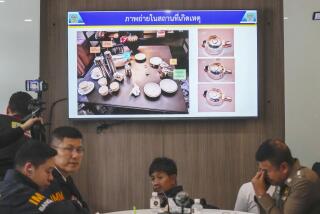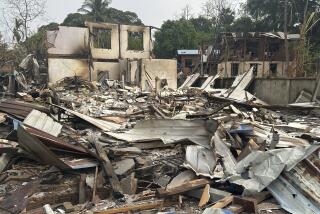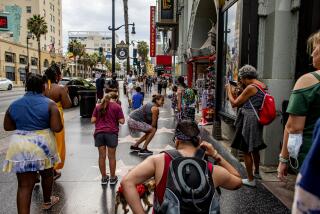Should You Go?
YANGON, Myanmar — If you’re one who believes in visiting the former Burma, you may or may not be up-to-date on the fatal repression, the global heroin trade and the strange stranded-in-the-’50s atmosphere here. But either way, your most visible enticement to this Southeastern Asian country is probably the tower that stands gleaming on a hill above the city once known as Rangoon.
The 300-foot-high spire of Shwedagon Pagoda is layered with tons of gold and thousands of jewels, a 76-carat diamond on top, surrounded by a riot of red and yellow paint, dragons and elephants in effigy, steeply pitched, ornament-heavy roofs and smoldering incense.
From dawn to dusk, long-suffering workaday Burmese and red-robed monks circle the 2,500-year-old site, their faces protected from the sun’s rays by yellowish rice paste. They nod to tourists, acquiesce to photos, kneel to meditate, perhaps reach to place a drooping blossom in a cup beneath a holy figure. W. Somerset Maugham wrote that the pagoda stood out “like a sudden hope in the dark night of the soul.”
One can take it as a symbol of Burmese spiritual resilience despite tyranny and poverty, as many American visitors do; or one can take it merely as a pretty picture, as Myanmar’s governing but nonelected State Law and Order Restoration Council (SLORC) would probably prefer.
In any event, the pagoda sells well. And the SLORC, eager to silence human rights activists calling for a tourism boycott of the country, is looking for more customers.
Over the last year, even as political pressures have led several international corporations to scale back their Burmese investments, Myanmar’s leaders have stepped up a ferocious campaign to lure Western tourists--and their hard currency. That campaign will accelerate in October with the start of “Visit Myanmar Year.”
The tourism campaign may pique the interest of adventurers who have heard of Myanmar as a gorgeous, exotic land that is only now beginning to show Western influences after more than 30 years of isolation. But the case of Myanmar raises a nagging question for modern-day travelers: Is my vacation a political act?
Many travelers, and most of those who make their living from tourism, argue that a tourist can’t be blamed for all doings in their destinations, or no one would ever leave home. Under that philosophy, crossing borders may put some money in the pockets of objectionable leaders but stands as a chance to communicate the ideals of democracy and perhaps spread some wealth among strangers living in need.
Over the last decade, travelers’ boycotts have been waged against destinations as disparate as South Africa, Arizona, Taiwan, Alaska and Norway in efforts to fight apartheid (now abandoned), the absence of a holiday honoring Martin Luther King Jr. (the state has since adopted one), black-market trading in rhino horns, controversial wolf-control programs (now suspended) and whale-killing. Those who wage these campaigns see tourist dollars as contributions to the wrong side, pure and simple.
Accordingly, visiting Myanmar “is not appropriate,” says Kyaw Tint, who fled the country in 1985 and now lives in Alhambra.
“All the facilities--the roads, the hotels and almost all the infrastructure used by tourists--are built by forced labor or foreign workers. Almost all of these hotels where tourists are going to stay are owned by the military or their families. If you go, the military is going to get profits. And if they have more money, they are going to make more oppression.”
*
Yet by some measures, the “Visit Myanmar” campaign is a success already.
Several large, upscale American travel companies have begun bringing travelers into Myanmar, including Abercrombie & Kent International, Classical Cruises & Tours, Geographic Expeditions, Butterfield & Robinson, Mountain Travel-Sobek and Radisson-Seven Seas Cruises. Stressing that they put as little money as possible into the government’s pockets, those companies report a small but growing number of bookings from adventurous American travelers.
Beyond Yangon, visitors to Myanmar are likely to head for the 4,000 pagodas and ruined temples of Pagan, the floating gardens of Inle Lake, the long and winding Ayeyarwady (formerly Irrawaddy) River, the former capital of Mandalay or a handful of other prime attractions. The tourists are on a tight leash, however: Travel to many regions is forbidden.
Jim Sano, president of Geographic Expeditions (formerly InnerAsia) of San Francisco, started sending travelers to Myanmar in 1991 and expects to send about 100 travelers this year. He reasons that visitors “constitute a critical source of information and base of support for the Burmese people.”
The other factor, says Sano, is that “if the vast majority of U.S. tour companies were to boycott Burma, it would be a speck of the entire tourism revenues going into that country”--an assertion that Myanmar’s boycotters dispute.
Burmese government officials say tourist arrivals have grown from fewer than 10,000 in 1989--the year after troops opened fire in the streets of Yangon, killing an estimated 3,000 pro-democracy demonstrators and bystanders--to more than 60,000 in 1994. (Last year’s numbers weren’t available.)
Those travelers who reach Myanmar find a world unto itself.
*
As tourists arrive on a sunny Saturday outside the monstrous concrete red-and-yellow Karaweik restaurant, designed to resemble a hulking royal barge on Yangon’s Kandawgyi Lake, a mysterious fellow appears, wearing a Department of Tourism badge and wielding a video camera. He tapes the foreigners, then vanishes.
On a muggy afternoon in the rural outskirts of Yangon, amid the buzz of mosquitoes and the smell of cows and chickens, a load of foreigners steps down from their bus, expecting a glass factory, finding instead a sort of junkyard path strewn with dust-coated glassware from years past. But inside a broad barn, they find a crew of shyly smiling workers standing in the blasting heat of a furnace, prodding, turning and blowing orange ingots of molten glass.
The cooled, hardened results of their work are spread on a table, including dozens of egg-size art pieces, twinkling with blue and green hues and suspended bubbles. These nuggets are the kind one finds in the elegantly lighted shop windows of Laguna Beach and Cambria for $40 apiece.
“A year ago, the price was about 5 cents each,” proprietor Myat-Aywe confesses in halting English. Now that more foreigners have come, he says, “it’s 50 cents. Half a dollar. Still not too high.”
The most affluent visitors stay at the teak-lined, 95-year-old, $300-a-night Strand Hotel, once the refuge of old colonials, now restored and run by the Amanresorts luxury chain.
Others choose a cruise on a newly refurbished 128-berth luxury ship, The Road to Mandalay, that since December has plied the Ayeyarwady between Mandalay and Pagan under the operation of Orient-Express Hotels. With two cruises weekly scheduled from September through May, and prices beginning at $1,500 per person for a three-night cruise, the company forecasts about 4,000 passengers this year.
The tourist options multiply weekly. As of March, Burmese officials counted 34 hotels under construction in Yangon, including projects from the prominent Asian chains Mandarin Oriental and Shangri-La.
“Generally, Myanmar people are quite content,” a government tour guide announces to a busload of Americans as they head toward the waterfront. One American asks if the bus can make a detour past the home of Aung San Suu Kyi, leader of anti-government dissenters. Guide and driver ignore the request. Another American asks how many people died in the 1988 unrest.
“Nobody knows,” says the guide. Shopping is next.
*
Alistair Ballantine, president of Abercrombie & Kent, which brings high-end tours into the country, has suggested that “being exposed to the political aspects of day-to-day life in Myanmar . . . turns ordinary travelers into advocates for a cause. They return home as goodwill ambassadors, bringing pressure to bear on their own governments to facilitate change.”
But Carol Richards, an independent anthropologist who is co-founder of the Santa Monica-based Burma Forum, asserts that there really is no free communication between the Burmese and tourists because “it’s very risky for a common person to speak with foreigners, and many tourists don’t realize that.”
In the armchair tour of Myanmar’s unromantic realities, the first stop would be just a few miles northwest of the Shwedagon Pagoda, on University Avenue.
There, under constant surveillance, stands the home of Suu Kyi, 51, winner of the 1991 Nobel Peace Prize. In that home she endured house arrest for six years. Since her formal release in 1995, Suu Kyi has delivered regular anti-SLORC speeches here, sometimes with American tourists in her frontyard audience. But in recent interviews, she has denounced casual tourism to her country as “tantamount to supporting authoritarianism in Burma” and thrown her support behind the effort to keep tourists away during Visit Myanmar Year.
(The SLORC issued its edict changing the country’s place-names in 1989; most opponents still use pre-SLORC terms.)
Suu Kyi gets vehement support from many Burmese refugees. An estimated 10,000 expatriates now live in Southern California. Many of them are active in groups that not only oppose tourism to Myanmar but call for consumer boycotts of companies that do business with the country, such as Los Angeles-based Unocal, which is helping build a $1-billion gas pipeline to Thailand, and PepsiCo, which recently sold a bottling plant in Myanmar but continues to maintain a presence in the country.
Next stop on the anti-itinerary might be the forests along Myanmar’s western and eastern borders. There, poppy-planting drug lords produced an estimated 220 tons of heroin last year, which the U.S. State Department says makes Myanmar the world leader in opium and heroin production.
By the State Department’s estimate, 60% of the heroin seized in the United States comes from Myanmar. But some is consumed at home, through dirty needles. Burma is believed to have the highest HIV infection rate in the world among intravenous drug users. Government complicity in the drug trade is widely suspected.
Next stop: perhaps a prison somewhere up the Ayeyarwady, where SLORC has jailed two comedians whose crime was making jokes about the government on Independence Day, Jan. 4. Amnesty International estimates the country’s political prisoners at more than 1,000, which doesn’t count most of the 300 dissidents arrested and released in a May crackdown.
Following that action, on May 23, the U.S. State Department cited “the potential for violence” and recommended “that U.S. citizens exercise all due caution in traveling in Burma and consider curtailing nonessential travel to Burma for the time being.”
That statement gives many travelers pause. Yet bookings continue. What is it, exactly, about Myanmar?
The average temperature is 80 degrees and the rainy season runs May through September. The leading sport is chinlon, which combines the challenges of volleyball and soccer using a ball woven from dried plant fronds. The common attire is a sarong known as a longyi. At some public bathrooms, men’s and women’s doors alike show skirted stick figures--the men’s figure has broader shoulders.
Buddhism is the dominant religion, and the population of 46 million is about 65% ethnic Burmese, the remainder made up of several minority groups, many of whom persist in rebellion against the current regime. After about a century of British colonialism and a Japanese invasion during World War II, Burma achieved independence in 1948. But in the course of the struggle, Burmese leader Aung San, head of the provisional government, was assassinated with most of his cabinet members in 1947. (Among the family members who survived him: a 2-year-old daughter, Aung San Suu Kyi.) But after a brief spell of fledgling parliamentary democracy, Gen. Ne Win grabbed control of the country in 1962 and set it on a doomed course of isolationist, superstitionist socialism.
The country’s territory is 1 1/2 times the size of California, rich with teak forests that are being rapidly felled, punctuated with deposits of jade and rubies, oil and gas, surrounded by racing engines of Southeast Asian economic growth. Under British colonialism, it was the world’s leading supplier of rice. Now it is counted among the world’s 10 poorest nations, with per capita income estimated at $280 a year.
Myanmar does, however, have its very own time zone, a perplexing half an hour ahead of Thailand’s, and thus 30 minutes out of step with the rest of the world. Since the early 1980s, Myanmar has had television, too, all government-programmed.
This is a country where numerology counts. In 1987, Ne Win introduced currency in 45-kyat and 90-kyat increments because he believed nine to be a lucky number. That same year, he declared 25-, 35- and 75-kyat notes worthless, thereby wiping out an estimated 80% of the country’s money in circulation, plunging millions of his subjects deeper into poverty.
Then there is the traffic. The prevailing explanation is that Ne Win’s astrologer told him that left was unlucky, and so in 1974 Ne Win rewrote the nation’s British-devised traffic system, instructing that cars would henceforth drive on the right side of the road. But since the country is so poor and trade so feeble, the streets of Yangon today are a jumble of battered bicycles with sidecars, some newish cars and many older, British-style, right-hand-drive vehicles, whose drivers crane their necks to see while jouncing down the right side of the road.
“Burma is the dotty eccentric of Asia, the queer maiden aunt who lives alone, and whom the maid has forgotten to visit,” wrote Pico Iyer in 1988.
Later that year, Ne Win resigned, SLORC took over, and it all began to seem a bit less quaint. Even as the nation’s leaders cracked its door open to outsiders--lengthening the maximum tourist stay from seven days to the current 30--the repression grew deeper and more violent, but no less eccentric.
Consider: Government leaders endorsed the massacre of protesters in 1988, then jailed Aung San Suu Kyi, and, in 1990, held parliamentary elections apparently expecting to win fair and square. When pro-democracy candidates instead won in a landslide, the SLORC voided the balloting.
*
Still, for a Westerner who sees a benefit to crossing lines, curiosity can be stronger than repulsion.
Along the alleys between Bogyoke Aung San and Anawrahta streets, travelers browse among booksellers who stack their wares on the sidewalk, the inventory running to Paul Erdman (“The Crash of ‘79”), Thomas Hardy (“Tess of the D’Urbervilles”), a few Tom Clancy offerings and many romances. English-language books are so prized that an entire cottage industry has risen in improvising cardboard bindings to lengthen these volumes’ lives.
Downtown in the Bogyoke Aung San Market, where locals gather to gossip and sip tea, visitors wander through a cavernous market area stuffed full of lacquerware, puppets, jewelry of varied quality and cheap T-shirts. Hand-carved teak picture frames fetch $9.
In the dim bar of the Strand hotel, meanwhile, a Mandalay beer goes for $4. On a slow Friday night, the freshly mopped marble floor is empty of customers and a melancholy clarinet-guitar-piano trio is at work. With a ceiling fan slowly circling overhead and colonial ghosts of Maugham and Rudyard Kipling floating just out of view, the players struggle through “Love Me Tender” and “Blue Moon,” waiting for those Westerners their government wants so badly to come.
(BEGIN TEXT OF INFOBOX / INFOGRAPHIC)
If you decide to go ...
A visa is required. For more information contact the Embassy of Myanmar, Information Officer, 2300 S St. NW, Washington, D.C. 20008, (202) 332-9044; fax (202) 332-9046.
The State Department’s Office of Overseas Citizens Services computerized phone system offers travel warnings and consular information updates on Myanmar and other countries. Telephone (202) 647-5225.
More to Read
Sign up for The Wild
We’ll help you find the best places to hike, bike and run, as well as the perfect silent spots for meditation and yoga.
You may occasionally receive promotional content from the Los Angeles Times.







